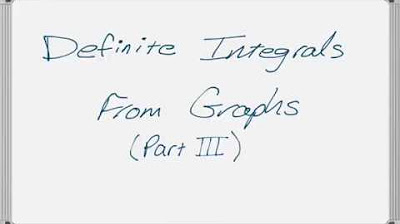Definite integral of absolute value function | AP Calculus AB | Khan Academy
TLDRThe video script presents a step-by-step guide to evaluating the definite integral of a function involving an absolute value, from negative four to zero. It explains how to handle the absolute value by breaking the function into a piecewise function based on the interval where the value inside the absolute value is positive or negative. The script then demonstrates how to calculate the integral for each interval and combine them to find the final result, which is four, using both algebraic methods and geometric reasoning.
Takeaways
- 📌 The problem involves evaluating the definite integral of a function with an absolute value from negative four to zero.
- 🔢 The function in question is f(x) = |x + 2|, which requires finding the anti-derivative to evaluate the integral.
- 🤔 The challenge is to handle the absolute value function, which can be done by rewriting the function as a piecewise function.
- 📈 The point of transition for the function is at x = -2, where the value inside the absolute value changes sign.
- 🔄 For x < -2, the function becomes -(x + 2), and for x ≥ -2, it simplifies to x + 2.
- 🧩 The integral is broken into two parts: from negative four to negative two and from negative two to zero.
- 📊 The first part (x < -2) corresponds to the area under the line y = -x - 2, and the second part (x ≥ -2) under the line y = x + 2.
- 🤏 The anti-derivative of -x is -x^2/2, and the anti-derivative of x is x^2/2 + 2x.
- 📐 Evaluating the anti-derivatives at the bounds gives us the areas under the respective curves.
- 🔢 The final result of the integral is 4, which is the sum of the areas from both parts of the function.
- 🏗️ The geometric argument for the result is that the area under both curves (each with a height of 2 and a base of 2) is 2, and their sum is 4.
Q & A
What is the function f(x) being discussed in the transcript?
-The function f(x) is |x + 2|, which represents the absolute value of x plus two.
What is the definite integral being evaluated in the script?
-The definite integral being evaluated is ∫ from -4 to 0 of |x + 2| dx.
How is the absolute value function handled in this context?
-The absolute value function is handled by rewriting it as a piecewise function, separating the intervals where the expression inside the absolute value is positive and where it is negative.
What is the critical point for the function f(x) = |x + 2|?
-The critical point for the function is x = -2, where x + 2 equals zero.
How does the function change its behavior at x = -2?
-At x = -2, the behavior of the function changes from being negative x + 2 (for x < -2) to x + 2 (for x ≥ -2).
What are the two intervals considered for the piecewise function?
-The two intervals considered are x < -2 and x ≥ -2.
How is the integral broken up for evaluation?
-The integral is broken up into two parts: the integral from -4 to -2 of -x - 2 dx and the integral from -2 to 0 of x + 2 dx.
What is the anti-derivative of -x?
-The anti-derivative of -x is -x^2/2.
What is the anti-derivative of x^2/2 + 2x?
-The anti-derivative of x^2/2 + 2x is (1/6)x^3 + x^2.
What is the final result of the definite integral?
-The final result of the definite integral is 4.
How does the geometric argument support the result of the integral?
-The geometric argument supports the result by considering the areas under the curves y = -x - 2 and y = x + 2 between the given intervals, which sum up to the area of a rectangle with dimensions 2 by 2, thus yielding a total area of 4.
Outlines
📚 Introduction to the Definite Integral of an Absolute Value Function
This paragraph introduces the concept of evaluating the definite integral of a function involving an absolute value. The voiceover presents the function f(x) as the absolute value of (x + 2) and sets the integration limits from -4 to 0. It encourages the viewer to pause and attempt the problem before proceeding. The key challenge is identifying how to find the antiderivative of an absolute value function, which is addressed by suggesting the use of a piecewise function to handle the different intervals where the expression inside the absolute value is positive or negative. The point of transition is identified as x = -2, where x + 2 equals zero.
📈 Analysis and Evaluation of the Definite Integral
This paragraph delves into the process of evaluating the definite integral by breaking it down into two parts, corresponding to the intervals where the function is defined piecewise. The first part involves the interval x < -2, where the function becomes -x - 2, and the second part is for the interval x ≥ -2, where the function simplifies to x + 2. The paragraph illustrates the functions graphically to aid understanding and proceeds to evaluate each integral separately. The antiderivatives are calculated, and the process involves finding the areas under the curves for the specified intervals. The final result of the integral is determined to be 4, with a geometric argument provided to confirm the correctness of the answer.
Mindmap
Keywords
💡Definite Integral
💡Anti-derivative
💡Absolute Value
💡Piecewise Function
💡Interval
💡Algebra
💡Graph
💡Symmetry
💡Area
💡Fundamental Theorem of Calculus
💡Derivative
Highlights
The problem involves evaluating the definite integral of a function with an absolute value from negative four to zero.
The key to solving the problem is to rewrite the function without the absolute value as a piecewise function.
The point at which the function changes is when x plus two equals zero, or x is equal to negative two.
For x greater than or equal to negative two, the function simplifies to x plus two.
For x less than negative two, the function becomes negative x plus two after applying the absolute value.
The integral is broken up into two parts to simplify the calculation: from negative four to negative two and from negative two to zero.
The first part of the integral corresponds to the area under the curve of negative x minus two from negative four to negative two.
The second part of the integral corresponds to the area under the curve of x plus two from negative two to zero.
The anti-derivative of negative x is negative x-squared over two, and the anti-derivative of x plus two is x-squared over two plus two x.
Evaluating the anti-derivative of negative x from negative four to negative two results in a value of two.
The anti-derivative of x plus two evaluated from negative two to zero results in a value of two.
The symmetry of the function about the vertical line x equals negative two is evident in the integral calculation.
The integral of the function is found to be four, which is confirmed by a geometric argument based on the areas under the curves.
The method used to solve the integral involves both algebraic manipulation and an understanding of the geometric interpretation of integrals.
The problem demonstrates the application of piecewise functions and the concept of absolute value in calculus.
The process of solving the integral is a combination of analytical and geometric approaches, providing a comprehensive understanding of the problem.
The integral's evaluation showcases the importance of correctly identifying and applying the anti-derivative to each part of the piecewise function.
The solution to the integral problem is verified through both algebraic calculation and a geometric interpretation of the area under the curves.
Transcripts
Browse More Related Video

Definite Integrals from Graphs (Part 3 of 3) - Absolute Value

Definite integral of piecewise function | AP Calculus AB | Khan Academy

Finding derivative with fundamental theorem of calculus: x is on lower bound | Khan Academy

AP Calculus Exam Tip: Definite Integral of Absolute Value Function

Evaluating Definite Integrals Using Geometry

Definite integral of trig function | AP Calculus AB | Khan Academy
5.0 / 5 (0 votes)
Thanks for rating: